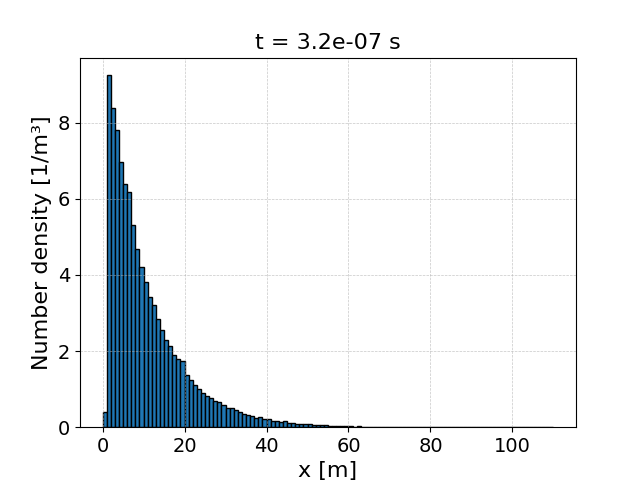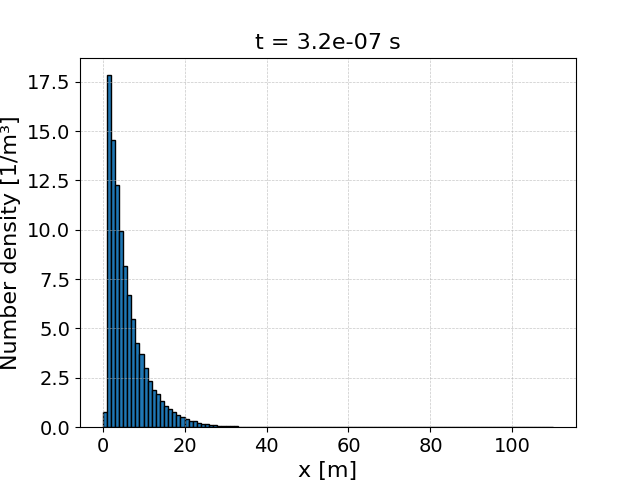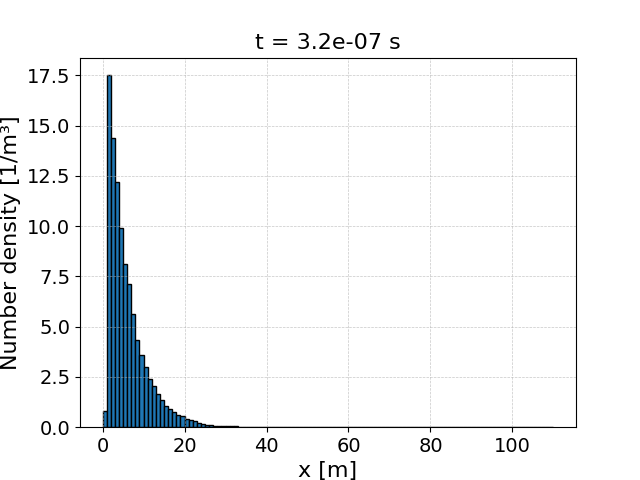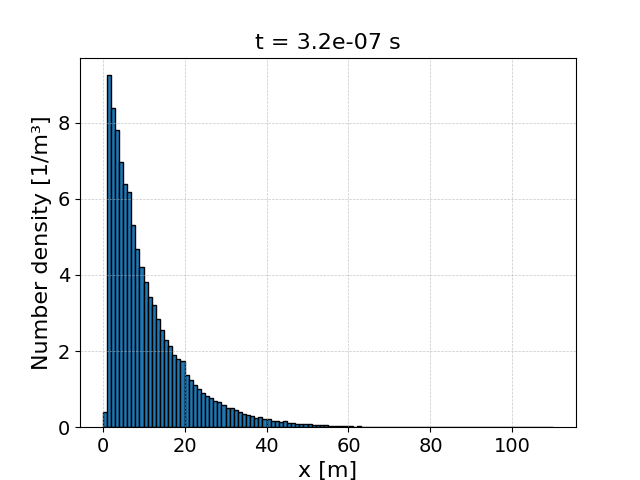Example 4: Particle background#
Some physics packages involve interaction with a background species, but don’t significantly modify the properties of background particles themselves. These packages are often described with a cross-section, and require the incident particle speed and the background number density to get a trigger-rate.
The physics package test_process_Z_background demonstrates this kind of
interaction. The process has a constant cross-section of 1.0e-3 m², and accepts
background species as arguments. Upon trigger, the incident electron momentum
\(p_x\) is set to zero. Multiple backgrounds may be specified, provided they all
represent the same type of particle. For multiple different backgrounds, the
processes must be setup separately.
These examples have a similar setup to Example 1, where a relativistic,
low-density electron bunch passes through the simulation window. A static
background of electrons is also present, which acts as the background species
for the test_process_Z_background interaction.
Four examples are provided for this system:
example_4_0: Default settingsexample_4_1: Two equivalent background species are usedexample_4_2: Two processes are used, with a shared backgroundexample_4_3: The background number density is saved, and updated less often
Example 4.0#
The incident electrons start in the first cell, and move across the domain at
relativistic speed. A uniform density of background particles is present, and
the cross-section of test_process_Z_background is also constant - hence, the
trigger rate is fixed for electrons in the incident species.
Upon trigger, the incident electron has its \(p_x\) set to 0, and will remain at the trigger location. Since the rate of trigger is constant, the density distribution is expected to form an exponential decay.
The physics package block takes the form:
begin:physics_package
process = test_process_Z_background
incident = Electron_bunch
background = Background_electrons
end:physics_package
The density at the end of the simulation is as expected:

Example 4.1#
This example also uses test_process_Z_background, with a constant
cross-section, and a uniform background density. This time, two equivalent
background densities are used.
In this case, the code can sum the number densities, and sample the process once with a combined density. This is an improvement on the FORTRAN code, where the trigger-test would be performed for each background separately, causing unnecessary computation.
The physics package block setup for this example is:
begin:physics_package
process = test_process_Z_background
incident = Electron_bunch
background = Background_electrons
background = Background_electrons2
end:physics_package
Background_electrons has the same number density as in Example 4.0, and
Background_electrons2 also has this density. Hence, since the number of target
particles has doubled, the trigger rate has also doubled. This can be seen with
the faster exponential decay in this simulation:

Example 4.2#
Instead of using one process with two identical backgrounds as in Example 4.1, here we create an equivalent system where two processes act on the same background. The code will only calculate the background number density once per step, and both processes will use this background array.
This uses the physics package block:
begin:physics_package
process = test_process_Z_background
incident = Electron_bunch
background = Background_electrons
end:physics_package
begin:physics_package
process = test_process_Z_background
incident = Electron_bunch
background = Background_electrons
end:physics_package
This setup is physically equivalent to Example 4.1, and we get the same exponential decay pattern in the number density.

Example 4.3#
In this example, a single test_process_Z_background is used with a single
background species, but the background number density is only calculated once
every 1.0e-7s in the simulation. The number density array is saved between these
calculations, which prevents re-calculating the density each step. This feature
is useful to reduce computational expense in systems where the number density
of background particles changes slowly.
Background array super-cycling was switched on using this physics package block:
begin:physics_package
process = test_process_Z_background
incident = Electron_bunch
background = Background_electrons
recalc_time_num_density = 1.0e-7
end:physics_package
As this example is physically equivalent to Example 4.0, it is good to see we get the same density profile:
